‘Strike, man, strike!’ – On the trail of London’s most notorious public execution sites
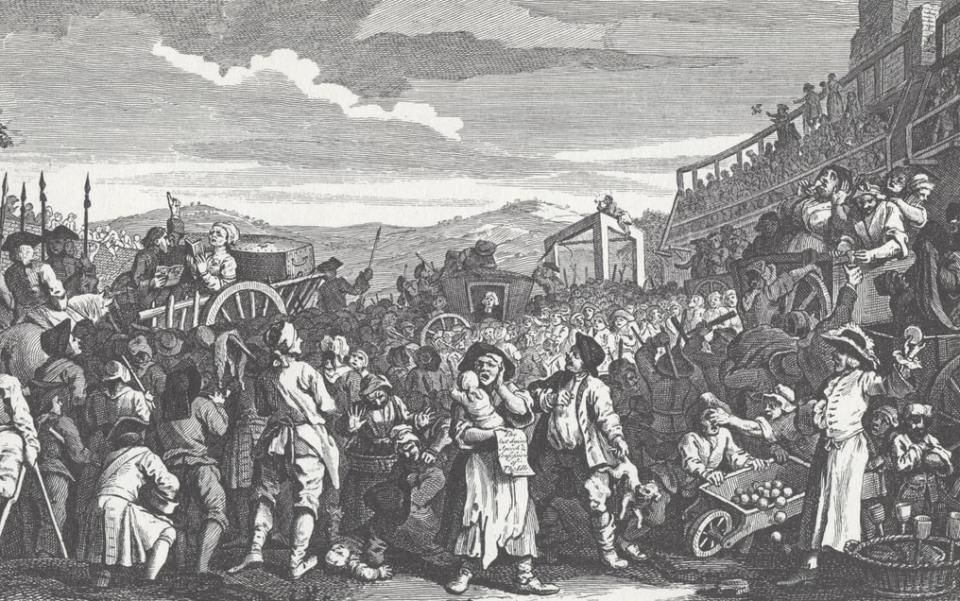
Join us for a macabre tour of the capital's most notorious public execution sites.
1. Smithfield
Many of the Marian Martyrs, protestants slaughtered under Queen Mary, met their demise at the Elms at Smithfield, London’s oldest execution site. St Bartholomew's Hospital features a plaque to commemorate several of them.
It was also the site of William Wallace’s execution in 1305. It happened much like in the movie, Braveheart (hung, drawn and quartered), though there is no evidence to support the blood curdling cry of “Freedom!”
Wallace’s head was tarred and put on display atop the southern gatehouse of London Bridge; his limbs were placed (separately) in Perth, Stirling, Berwick and Newcastle, and a quarter was sent to Aberdeen (it’s said to be entombed in the walls of St Machar's Cathedral). A memorial to the Scot can be seen today outside St Bartholomew's. In 1869 the Wallace Monument was erected near Stirling Bridge.
Smithfield was originally known as “Smooth Field”, and was a grassy area beyond the old city walls with easy access to grazing and water (from the Fleet river), making it a logical location for a livestock market (as well as summer fairs and the occasional public hanging).
Others killed there include Wat Tyler (cut down by the Mayor of London), John Badby (burned in a barrel) and Richard Rouse (boiled to death).
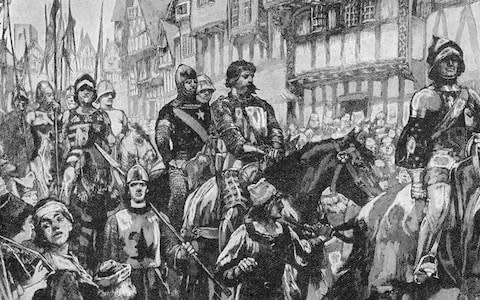
2. Tyburn
Smithfield fell from favour as an execution site in the 1400s, with Tyburn (close to the modern landmark of Marble Arch, one of central London’s busiest corners) seizing the limelight. Back then it was a mere village, but it soon became synonymous with public executions.
Prisoners would be taken there from Newgate Prison, via St Giles in the Fields and Oxford Street, with some permitted a final drink at a pub en route – the source of the phrase “one for the road”, some believe.
The dream of all condemned criminals would be an escape on the way to the gallows - or from prison - and a mad dash to the nearest church, where sanctuary might be found. St Martin’s Le Grand was a popular option. “In 1430, a soldier called Knight was languishing in Newgate Prison,” writes Dr Matthew Green in his book London: A Travel Guide Through Time. “A group of cunning friends fabricated debt charges against him, requiring him to be frogmarched to Guildhall - St Martin’s lay on the route. Lying in ambush in Panyer Alley, they waited until he was taken past the south side of the church, then leaped out and dragged him into the precinct. Violating the ancient laws of sanctuary, the sheriffs, aldermen and the City Chamberlain along with a crowd of people stormed St Martin’s and wrenched Knight and his rescuers out, slamming them all up in Newgate. Ultimately the case was bounced up to Star Chamber, the highest legal court in the land, which, on the king’s instruction, free the five and returned Knight to his sanctuary, underlining its inviolable nature in the eyes of the law.”
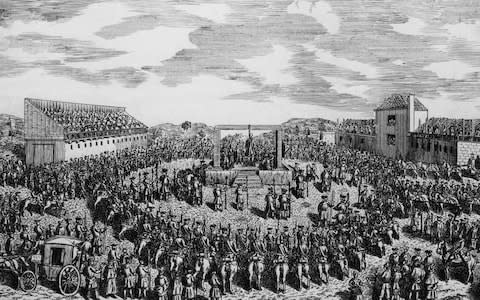
A stone memorial can be seen on the pavement marking the spot where the Tyburn Tree, its distinctive three-sided gallows, once stood. The design meant multiple hangings could be carried out at once, such as on June 23, 1649, when 24 prisoners were hanged simultaneously, having been conveyed there in eight carts. You can get a sense of the chaos of the crowds attending these events in Hogarth’s etching The Idle Apprentice.
Oliver Cromwell's exhumed body was, symbolically, hanged at Tyburn in 1661.
Several euphemism reflect Tyburn’s grisly role in London life, including to “take a ride to Tyburn” and to “dance the Tyburn jig”.
3. Newgate Prison
In use for more than 700 years – from 1188 to 1902 – and the site of London’s gallows after Tyburn was retired from duty in 1783. The executions took place in public – with the gallows set up on Newgate Street – until 1868.
The prison, whose former inmates include Casanova, Rob Roy, Ben Jonson, William Kidd and Daniel Defoe – was demolished in 1904. The Old Bailey occupies the main site, but head to the church of St Sepulchre-without-Newgate to see the old jail’s execution bell, Amen Court, which is home to a surviving wall, or The Viaduct Tavern, where five former cells of a neighbouring lock-up are visible in the basement.
What was a stay in Newgate like? “Hell itself, in comparison, cannot be such a place,” wrote one unfortunately resident in 1662. Kelly Grovier’s book The Gaol adds: “The mingled stench of disease and faeces and the cacophonous din of wailing and screeching in the maze of unventilated wards was unutterably horrifying.”
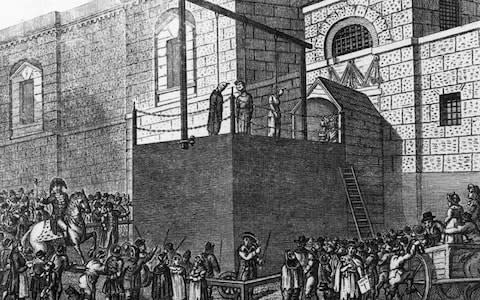
4. The Tower and Tower Hill
Just a handful of prisoners were actually executed inside the grounds of the Tower. They include Anne Boleyn, Lady Jane Grey and Robert Devereux, all of whom were given the chop on Tower Green – a memorial marks the spot (though there is now doubt that this is actually the exact site of the executions).
Far more met their demise on Tower Hill, in full gaze of the public, including Thomas Cromwell and Sir Thomas More. Cromwell’s death was laboured, according to some. A Tudor historian wrote that he “patiently suffered the stroke of the axe, by a ragged and butcherly miser, who very ungoodly performed the office”. Other accounts suggest it was a quick death, however.
Today, the site of the scaffold is laid out as a memorial garden. The Hung Drawn & Quartered pub, on Great Tower St, would make a suitable spot for last orders.
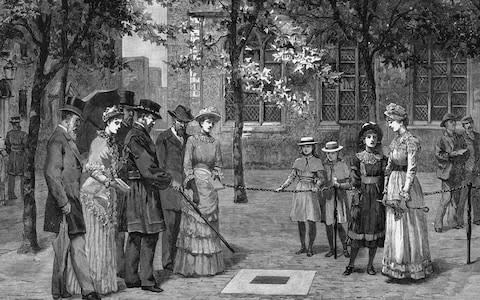
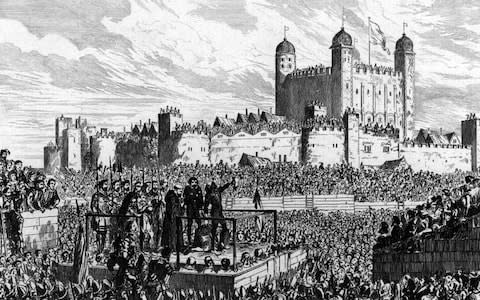
5. Lincoln’s Inn Fields
London’s largest public square has played host to a clutch of gruesome endings. Among them was Lord William Russell, convicted of plotting to kill Charles II. Jack Ketch, somewhat notorious for his lack of skill with the executioner’s axe, was given the job. The first blow led Russell to cry: “You dog, did I give you 10 guineas to use me so inhumanely?" – three further swipes were needed to dismember him. Ketch repeated the trick with the beheading of James Scott, 1st Duke of Monmouth (at Tower Hill), when it took him five chops to remove the head.
Another grisly execution at Lincoln’s Inn Fields was that of Anthony Babington for conspiring with Mary, Queen of Scots. The full sentence was as follows: “From (the Tower of London) you shall be drawn on a hurdle through the open streets to the place of execution, there to be hanged and cut down alive, and your body shall be opened, your heart and bowels plucked out, and your privy members cut off and thrown into the fire before your eyes. Then your head to be stricken off from your body, and your body shall be divided into four quarters, to be disposed of at (the Queen's) pleasure.” Legend has it Babington was still conscious when his “privy members” were being toasted.
A bandstand occupies the site of the executions. Afterwards, head to Sir John Soane’s museum, filled with curiosities. It holds candlelit evening openings each month.

6. Execution Dock
For more than 400 years pirates, smugglers and mutineers sentenced to death by Admiralty courts swung at this scaffold on the banks of the Thames at Wapping. Most were brought from Marshalsea, a prison in Southwark (on what is now Borough High Street – look out for a plaque on the prison’s last remaining wall). The execution procession took them over London Bridge and past the Tower, with a stop at a public house, for a final quart of ale, customary.
Until the end of the 18th century, the bodies of pirates were often left on the noose until at least three tides has washed over their heads. Others were displayed at Cuckold’s Point, on the Rotherhithe peninsula, or Blackwall Point, on the Greenwich peninsula, as a warning to others.
Perhaps the most famous execution here was that of Captain Kidd in 1701. A riverside pub is now named in his honour, while a replica of the gallows can be seen outside a second (The Prospect of Whitby).
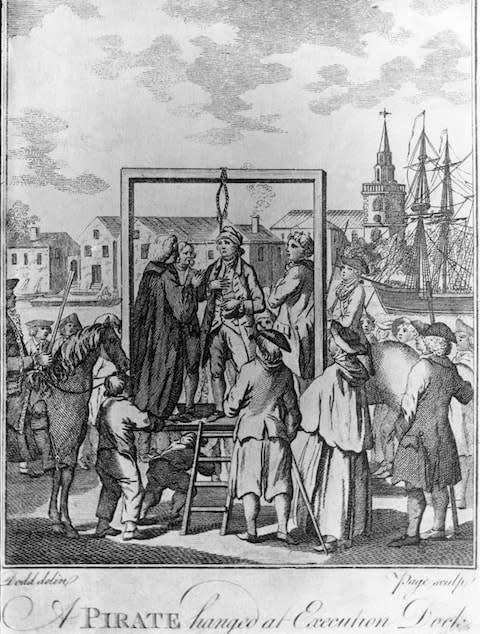
7. St Paul’s Churchyard
Just a handful have been executed in the shadow of London’s finest cathedral, including Henry Garnet, convicted of complicity in the Gunpowder Plot. Though sentenced to be hung, drawn and quartered, sympathetic onlookers reportedly pulled on the priest’s legs to end the ordeal early.
The exact spot of the execution is not known. Get your fix of the macabre by inspecting the final resting places of Nelson, Wellington, Wren et al in the cathedral and its crypt.
Back then, few realise, St Paul’s was renowned for its booksellers. The whole vicinity was packed with stalls thanks to its proximity to the Stationers’ Company, which held a monopoly on publishing. “The shops were distinguishable by their fantastical signs, some evocative of the romances and dramas purveyed within,” writes Dr Matthew Green. “Against Dean’s Wall was the Brazen Serpent, Holy Ghost, Love and Death and Green Dragon, where The Merchant of Venice went on sale in 1600. There was also the Black Bear, which was one of the first places to sell an anthology of Shakespeare’s plays in 1632. Against the cathedral wall on the west of Paul’s Cross, you had the Tiger’s Head and the Fleur-de-lis, where the Merry Wives of Windsor was once stocked. Over the wall on the southern side of Paternoster Row were the Mermaid and the Golden Anchor. And the White Lion and White Horse, so ethereal sounding, plied their trade from Pissing Alley.”

8. Banqueting House
Charles I lost his head on a temporary gallows erected outside Banqueting House on Whitehall. A bust of the former king marks the spot.
Historic Royal Palaces tells the story: “A huge crowd had gathered in the bitter weather. But they were held so far away that the King’s final short speech was lost in the freezing air. Erected against the Banqueting House, the scaffold was hung round with black cloth. In the centre of the blackened and sanded floor stood the axe and a lower quartering block of a kind used to dismember traitors. Two men, heavily disguised with masks, stood ready to perform the act. The King, his hair now bound in a white nightcap, took off his cloak and laid down. He told the executioner that he would say a short prayer, and then give a signal that he was ready. After a little pause, the King stretched out his hand, and the axe fell, the executioner severing his head in one clean blow.”
Banqueting House, the only surviving part of the Palace of Whitehall, can be visited for a shade more than a fiver. Refresh yourself at The Old Shades - a characterful little Victorian pub clad in wood and with real ales behind the bar, it features in our Monopoly pub crawl.
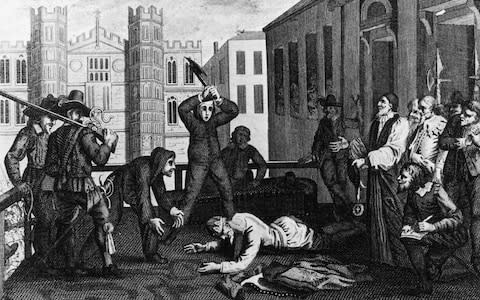
9. Charing Cross
Site of the final Eleanor Cross, inexplicably torn down in the 17th century (before the Victorians built the replica), this spot traditionally marks the centre of London and was once the location for all manner of public brutality. Alongside the statue of Charles I once stood a pillory, where ne'er-do-wells were flogged. Executions also took place, including those of several of the regicides of the beheaded king.
Samuel Pepys, the diarist, recalled the carnival atmosphere that the square once had, with street entertainers and numerous taverns (such as the Golden Cross, with features in David Copperfield and The Pickwick Papers) attracting a boisterous crowd. He wrote: “Out to Charing Cross to see Major-General Harrison hanged, drawn, and quartered; which was done there, he looking as cheerful as any man could do in that condition.”

10. Old Palace Yard
The grounds in front of the Palace of Westminster was where Guy Fawkes met his end in 1606 – symbolically, opposite the building he had tried to destroy. He, and his co-conspirators, got the old “hung, drawn and quartered” treatment, with their genitals also removed and burnt before their eyes.
Sir Walter Raleigh joined him 12 years later, and took it with aplomb, his final words being a somewhat impatient: “Strike, man, strike!” The head was later put in a red leather bag, and Raleigh’s wife kept it with her for the rest of her days.

11. Kennington Common
South London’s equivalent to Tyburn were the Surrey Gallows, which stood on the site of St Mark’s Church, close to Oval underground station. Records suggest at least 129 men and 12 women were sent to meet their maker here, including a number of Jacobites and highway robbers.

For a remarkably detailed record of public executions in Britain, see www.capitalpunishmentuk.org.

